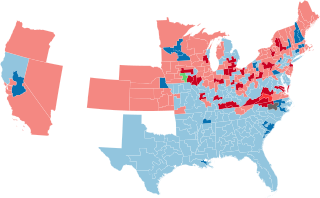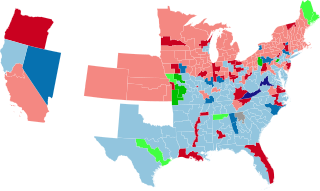
The 1920 United States House of Representatives elections were elections for the United States House of Representatives to elect members to serve in the 67th United States Congress. They were held for the most part on November 2, 1920, while Maine held its on September 13. They coincided with the election of President Warren G. Harding, the first time that women in all states were allowed to vote in federal elections after the passage of the 19th Amendment.

1914 United States House of Representatives elections were elections for the United States House of Representatives to elect members to serve in the 64th United States Congress. They were held for the most part on November 3, 1914, while Maine held theirs on September 14. They were held in the middle of President Woodrow Wilson's first term.

The 1912 United States House of Representatives elections were elections for the United States House of Representatives to elect members to serve in the 63rd United States Congress. They were held for the most part on November 5, 1912, while Maine and Vermont held theirs in September. They coincided with the election of President Woodrow Wilson.
The 1908 United States House of Representatives elections were held for the most part on November 3, 1908, with Oregon, Maine, and Vermont holding theirs early in either June or September. They coincided with the 1908 United States presidential election, which William Howard Taft won. Elections were held for all 391 seats of the United States House of Representatives, representing 46 states, to serve in the 61st United States Congress.

The 1894 United States House of Representatives elections were held from June 4, 1894, to November 6, 1894, with special elections throughout the year. Elections were held to elect representatives from all 356 congressional districts across each of the 44 U.S. states at the time, as well as non-voting delegates from the inhabited U.S. territories. The winners of this election served in the 54th Congress, with seats apportioned among the states based on the 1890 United States census.

The 1886 United States House of Representatives elections were held for the most part on November 2, 1886, with three states holding theirs early between June and September. They occurred in the middle of President Grover Cleveland's first term. Elections were held for 325 seats of the United States House of Representatives, representing 38 states, to serve in the 50th United States Congress. Special elections were also held throughout the year.

The 1882 United States House of Representatives elections were held for the most part on November 7, 1882, with five states holding theirs early between June and October. They occurred during President Chester A. Arthur's term. Elections were held for 325 seats of the United States House of Representatives, representing 38 states, to serve in the 48th United States Congress. They were the first elections after reapportionment following the 1880 United States census, increasing the size of the House. Special elections were also held throughout the year.

The 1880 United States House of Representatives elections were held for the most part on November 2, 1880, with five states holding theirs early between June and October. They coincided with the 1880 presidential election which was won by James A. Garfield, who was a member of the House at the time. Elections were held for 293 seats of the United States House of Representatives, representing 38 states, to serve in the 47th United States Congress. This was the first time that every state held their regular House elections on or before Election Day. Special elections were also held throughout the year.

The 1866–67 United States House of Representatives elections were held on various dates in various states between June 4, 1866, and September 6, 1867. They occurred during President Andrew Johnson's term just one year after the American Civil War ended when the Union defeated the Confederacy. Each state set its own date for its elections to the House of Representatives. Members were elected before or after the first session of the 40th United States Congress convened on March 4, 1867, including the at-large seat from the new state of Nebraska. Ten secessionist states still had not yet been readmitted, and therefore were not seated.

The 1864–65 United States House of Representatives elections were held on various dates in various states between June 5, 1864, and November 7, 1865, in the midst of the American Civil War and President Abraham Lincoln's reelection. Each state set its own date for its elections to the House of Representatives. Members were elected before the first session of the 39th United States Congress convened on December 4, 1865, including the at-large seat from the new state of Nevada, and the 8 from Tennessee, the first secessionist state to be readmitted. The other 10 secessionist states had not yet been readmitted, and therefore were not seated.

The 1846–47 United States House of Representatives elections were held on various dates in various states between August 2, 1846, and November 2, 1847. Each state set its own date for its elections to the House of Representatives. 228 elected members representing 29 states took their seats when the first session of the 30th United States Congress convened December 6, 1847. The new states of Iowa and Texas elected their first representatives during this election cycle. These elections were held during President James K. Polk's term.
The 1836–37 United States House of Representatives elections were held on various dates in various states between July 4, 1836, and November 7, 1837. Each state set its own date for its elections to the House of Representatives, either before or after the first session of the 25th United States Congress convened on September 4, 1837. With Arkansas and Michigan officially achieving statehood in 1836 and 1837, respectively, the size of the House was set at 242 seats.

The 1834–35 United States House of Representatives elections were held on various dates in various states between July 7, 1834, and November 5, 1835. Each state set its own date for its elections to the House of Representatives before the first session of the 24th United States Congress convened on December 7, 1835. They were held during President Andrew Jackson's second term. Elections were held for 240 seats that represented 24 states, as well as the at-large-district seat for the pending new state of Michigan.

The 1832–33 United States House of Representatives elections were held on various dates in various states between July 2, 1832, and October 7, 1833. Each state set its own date for its elections to the House of Representatives before the first session of the 23rd United States Congress convened on December 2, 1833. They were held concurrently with the 1832 presidential election, in which Democrat Andrew Jackson was re-elected. The congressional reapportionment based on the 1830 United States census increased the size of the House to 240 seats.
There were ten special elections to the United States House of Representatives in 1933, to both the 72nd United States Congress and the 73rd United States Congress.
There were twelve special elections in 1947 to the United States House of Representatives during the 80th United States Congress. Each party held all of its seats elected in 1947, with the majority Republican Party keeping its seven seats, and President Harry Truman's Democratic Party keeping its five. Therefore, no party lost or gained U.S House seats in 1947.
There were several special elections to the United States House of Representatives in 1937 during the 76th United States Congress.
There were several special elections to the United States House of Representatives in 1937 during the 75th United States Congress.
There were nine total elections to the United States House of Representatives in 1911 during the 62nd United States Congress. Two of them were to fill the seats for the new states of Arizona and New Mexico, and the other seven were special elections to fill vacancies.











